- News
- Reviews
- Bikes
- Accessories
- Accessories - misc
- Computer mounts
- Bags
- Bar ends
- Bike bags & cases
- Bottle cages
- Bottles
- Cameras
- Car racks
- Child seats
- Computers
- Glasses
- GPS units
- Helmets
- Lights - front
- Lights - rear
- Lights - sets
- Locks
- Mirrors
- Mudguards
- Racks
- Pumps & CO2 inflators
- Puncture kits
- Reflectives
- Smart watches
- Stands and racks
- Trailers
- Clothing
- Components
- Bar tape & grips
- Bottom brackets
- Brake & gear cables
- Brake & STI levers
- Brake pads & spares
- Brakes
- Cassettes & freewheels
- Chains
- Chainsets & chainrings
- Derailleurs - front
- Derailleurs - rear
- Forks
- Gear levers & shifters
- Groupsets
- Handlebars & extensions
- Headsets
- Hubs
- Inner tubes
- Pedals
- Quick releases & skewers
- Saddles
- Seatposts
- Stems
- Wheels
- Tyres
- Health, fitness and nutrition
- Tools and workshop
- Miscellaneous
- Cross country mountain bikes
- Tubeless valves
- Buyers Guides
- Features
- Forum
- Recommends
- Podcast
review
£1,150.00
VERDICT:
Efficient, versatile and surprisingly comfortable aero bike, but look out for cross winds
Weight:
8,830g
Contact:
www.culpritbicycles.com
At road.cc every product is thoroughly tested for as long as it takes to get a proper insight into how well it works. Our reviewers are experienced cyclists that we trust to be objective. While we strive to ensure that opinions expressed are backed up by facts, reviews are by their nature an informed opinion, not a definitive verdict. We don't intentionally try to break anything (except locks) but we do try to look for weak points in any design. The overall score is not just an average of the other scores: it reflects both a product's function and value – with value determined by how a product compares with items of similar spec, quality, and price.
What the road.cc scores meanGood scores are more common than bad, because fortunately good products are more common than bad.
- Exceptional
- Excellent
- Very Good
- Good
- Quite good
- Average
- Not so good
- Poor
- Bad
- Appalling
Culprit: [kuhl-prit] - a person or other agent guilty of or responsible for an offense or fault.
An interesting choice of name for a bike manufacturer, then. Culprit Cycles hails from Taiwan and is run by Joshua Colp, formerly of Trigon Cycles. From what we've seen so far, they are not afraid of slinging the rule book out of the window when designing their bikes, so perhaps the name is not as odd as it sounds at first.

We've previously brought you news of their Legend triathlon bike which was launched at the Taipei show a year ago and caused quite a stir, lacking as it did any seatstays. This was apparently intended to allow for - you've guessed it - some vertical compliance, as well as apparently offering an aerodynamic benefit. For those unsure about the physics, there is a video online of someone removing the seatstays from a Cervélo RS and then riding it - don't Google it if you are easily upset by scenes of bicycle abuse. Culprit also sells an interesting range of kids' racing bikes.
We've not had the chance to sling a leg over The Legend, but we've been testing the Croz Blade, another innovative bike available as a frame or with a variety of builds. The Croz Blade is an aero-framed carbon road bike which distinguishes itself by allowing for disc brakes AND rim brakes - not a combination we've previously tested.

Culprit have just relaunched their website which includes a fun bike-designer app where you can choose the colour and build of your bike, so if you don't like the black and yellow colourway of our test unit, you can choose something completely different. At time of writing there are a few issues with it though. Our test frame has been built up using Shimano's new hydraulic discs and Ultegra Di2 groupset, and finished with Pro kit (Pro is a Shimano brand).
As ridden, it was fitted with Shimano's RX31 centre-lock wheels and the clever bimetallic ICE rotors (160mm at the front and 140mm at the rear). This gave an all-up weight of 8.8kg - no concerns for the UCI here, at least. Disc brakes are now permitted for cyclocross racing but not yet for the road. Perhaps with this in mind, the Croz Blade can also be fitted with TRP TTV aerodynamic V-brakes, which mount out of the wind (underneath the seat-stays and behind the fork).

If you're in the market for a bike that you can race today, then this will clearly be welcome. Don't underestimate the faff involved in changing one brake system for the other, however. Switching the hydraulics for cable-actuated V-brakes would not be a five-minute job, and would require new dual-control levers, of course.
During the test period, we switched out the wheels for some lighter and deeper Reynolds Assault disc wheels. As these had six-bolt hubs we also changed the rotors for some Tektro Lyra rotors. We will be reviewing the 2014 Ultegra Di2 11 speed groupset elsewhere, as well as the non-series hydraulic disc brakes and the Reynolds wheels. This review, therefore, will focus on the frameset.

It is certainly a striking looking frame. The aero tubeset and "look at me" paint job inspired strong feelings in most who saw it: it is quite apt that ours came in the Marmite colours. I had more positive comments than negative while out testing it, and I personally like the look of it. I am less enthusiastic about the Blade Runner logo, it must be said.
The Croz Blade is so named, say Culprit, because it's a "bike that is ready to cross over to road disc when you are. Croz for the Cross from rim to disc, Blade due to the frame being an aero road bike". Most people I encountered assumed that the Croz was because it's a cyclocross bike, an impression perhaps reinforced by the presence of disc brakes. A closer look at the tyre clearance and frame profiles are enough to establish its road credentials, however.

The frame has several other areas of interest. The down tube and seat tube are teardrop shaped, (as opposed to the truncated Kamm-tail which is becoming more popular elsewhere), with the trailing edge of the seat tube following the line of the rear wheel. This is the first bike frame I've ridden where you can flex certain areas of the frame between finger and thumb - the pointy side of the down tube evidently doesn't take too much load. This slightly freaked me out when I first noticed it, I admit.
The carbon aero seat post is a neat design, with three large clamp holes at the top allowing a really wide range of fore-aft positions (such that you could put some tri bars on and achieve a much more aggressive position for a time trial or triathlon). I tried moving it around and, perhaps unsurprisingly, ended up plumping for the middle one. Unusually, the seat rails are clamped from the sides, with some machined aluminium pieces held together with a single bolt to grip each rail. An unfortunate consequence of this design is that it limits the size of rails that you can use.
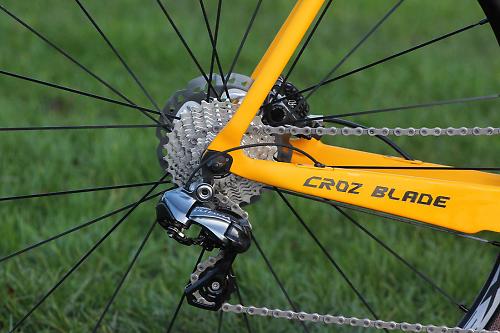
During the first couple of long rides it was hard not to be irritated by the rattly cockpit. As we've noted before, the hydraulic/Di2 controls tend to be a bit more rattly than their cable-operated brethren because they lack the cable tension that keeps everything quiet. Over time either I became immune to this or an accumulation of winter gunk quietened things down - either way it wasn't a big deal.
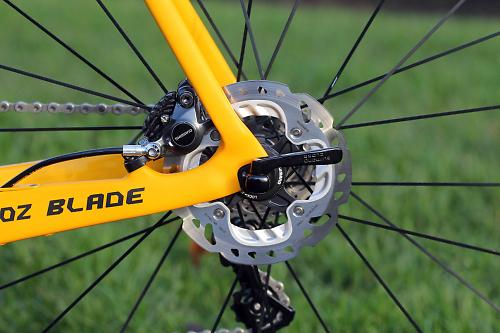
A major advantage of this combination of controls (shifting via electrons and braking via oil) is that neither is affected by bend radius. Accordingly, neat internal cable-routing is possible with no detriment to shifting or brake feel. I'd like to see the cables entirely concealed via the stem, à la Factor.
On the road, the Croz Blade is a fast, stiff ride. Power applied translates efficiently to forward motion and it is eager to launch you up the road, despite not being especially light. While the latest Ultegra Di2 is no heavier than its mechanical sibling, the discs add a bit of heft, but this is still no slouch. Fitting lighter finishing kit would see you approach 8kg, which is respectable if not earth-shattering.
Culprit claim a weight of 1,150g for the 56cm frame (unpainted) and 470g for the fork; that's not especially light for a race frame but there's clearly some extra layers of carbon in there to deal with the disc brake forces, and aero frames tend to be a bit heavier anyway.
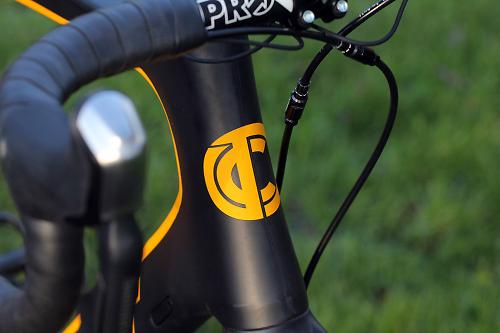
The bottom bracket area is substantial - ours was BB30-spec but at the Taipei show Culprit told us that they're switching to a BB386. There's no discernible flex, in any case. Out back there are substantial chainstays and fairly slender seat-stays - not quite the clichéd "pencil thin", though.
Nevertheless, once I'd ditched the Turnix saddle, I found somewhat to my surprise that the Croz Blade was a great place to spend long days in the saddle. It might have looked an odd choice for a couple of winter audaxes, but on both occasions I felt far fresher after nigh-on 200km than I expected. I think this was a consequence of two aspects of the frame's design - the aerodynamic benefits mean you're doing just a little less work, and a well-judged rear end means you're not getting too beaten up in the process.
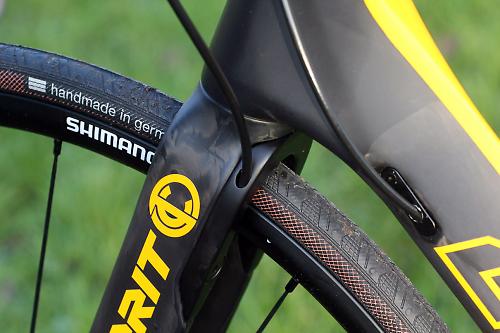
Upfront there's a tapered head-tube - 1 1/8in at the top and 1 1/2in at the bottom. This keeps the front wheel well in control despite the fairly slender bladed fork. A cover is fitted at the back of the forks, where TTV brakes would fit, and when using discs the front brake hose runs neatly through this. In addition to the hydraulic discs and TTVs, Culprit tell us that TRP Spyre mechanical discs would fit, but other mechanical disc brakes would not, due to geometry of the rear triangle. There are adaptors for the rear dropouts which allow you to use either a 135mm rear hub (now pretty much standard for discs) or 130mm if you're using the TTVs.
Geometry is fairly typical for the modern aero frame - not super low at the front (190mm head-tube on our XL) and with matching 73 degree head-tube and seat-tubes, again on the XL. With such a wide range of seat positions possible, I found it was easy to get a position which suited me well.

The Reynolds Assault wheels are what Culprit fit to their Ultegra Di2 and SRAM Red builds, and in most circumstances I found them to be a good match for the racey feel of the bike. On windy days, however, the bike tended to exhibit a rather divided character. When pedalling into the wind I appreciated the aerodynamic advantages of the frame and wheels, requiring less power to maintain speed than on a non-aero bike.
On descents, however, things sometimes became a bit less enjoyable. The Croz Blade seems to become more affected by cross-wind the faster you go, and on occasion became unstable and downright scary at around 35mph or more. It almost felt as though there was a resonance being excited in the frame in certain conditions. This was not something I noticed when using the shallower Shimano wheels, but the combination of the deeper Reynolds wheels and deep frame tubes made it hard to hold a line when descending.

On still days this was not an issue and the bike let me descend with confidence - disc brakes helping here. A number of other bike companies now feature truncated Kamm-tail tubes on their aero frames and claim that this makes them more stable in the wind without reducing aerodynamic efficiency.
Culprit originally designed the bike (in 2012) to work with the TRP Parabox system, a converter which allowed the use of conventional brake levers and hydraulic brakes - at that stage there weren't any hydraulic road brakes. Build options now start with a SRAM Apex setup ($2,995 or approximately £1,800, plus shipping and duties) and run up to Ultegra Di2 ($5,195 / £3,130) or SRAM Red ($5,095 / £3,070) builds, all with hydraulic brakes. Want to race? The SRAM Red build with TTVs is $5,295 / £3,190. Wheels are mostly from Reynolds, ranging from the Status Pro aluminium set on the Apex model up to the Aero 58s on the SRAM Red build.
Buying the frameset for $1,895 / £1,150 includes two sets of brakes (TTVs and Spyre mechanical discs).

Note that these prices do not include shipping or import duty and VAT, so budget for a hefty wedge on top of that - 15 percent import duty for the complete bike, 20 percent VAT, shipping, insurance and customs charges can all add up to an extra 50 percent or more. All in, the complete bike pictured would cost you around £4,600 - that's including shipping, duty and VAT.
Bikes and frames are supplied with torque wrench, carbon bottle cage, bottle, and Culprit bibs and jersey in a range of sizes.
Conclusion
There's a lot to like here. This is a bike designed to tick a lot of boxes, including the current aero and disc-brake buzz. If you're tempted by discs but want to be able to race under the current UCI regulations, the Croz Blade allows you to run rim brakes and switch if the rules change. In this build, with Di2 and hydraulic discs, it's impossible to deny that both offer real-world improvements over their conventional alternatives.
The Croz Blade's trick seat post allows you to switch between an ultra-aggressive position for time-trialling and a more conventional road set-up. Culprit have done well to offer a wide range of builds to suit different budgets, as well as offering a frame-set for those who want to build up their own spec.
It's an efficient, aerodynamic and fast bike. It was a pleasant surprise to find what a capable long-distance ride the Croz Blade was. Of course, this is a lot down to fit, saddle and tyre choice, but the frame plays an important part too. Our one reservation is the bike's high-speed stability in the wind. More than one tester found that as speeds increased, so did the difficulty in holding a line. Aero frames with deep-section wheels are generally more susceptible to lateral wind anyway, but we found the Croz Blade suffered from this more than most.
Verdict
Efficient, versatile and surprisingly comfortable aero bike, but look out for cross winds.
road.cc test report
Make and model: Culprit Croz Blade
Size tested: n/a
About the bike
State the frame and fork material and method of construction. List the components used to build up the bike.
The Croz Blade is a monocoque carbon frame made from high stiffness Toray T800 carbon, with full-carbon fork. Here it was built up with 11-speed Ultegra Di2, Shimano hydraulic disc brakes, Shimano RX31 wheels (later switched for Reynolds Assault SLG Disc) and Pro finishing kit.
Tell us what the bike is for, and who it's aimed at. What do the manufacturers say about it? How does that compare to your own feelings about the bike?
Culprit say this is "a bike for whatever the future may hold", for the rider who wants to keep all their options open - it can run discs or rim brakes, conventional gears or electronic shifting. If that's you, then it is a strong candidate in a fairly sparse field. If you're not interested in discs, you may choose to look elsewhere.
Frame and fork
Overall rating for frame and fork
8/10
Tell us about the build quality and finish of the frame and fork?
It's a well-built frame and fork. Both are unsurprisingly a little heavier than you'd expect from a non-disc setup, but they are well finished and appear of good quality.
Tell us about the materials used in the frame and fork?
Toray T800
Tell us about the geometry of the frame and fork?
Our XL (58cm effective top tube) has 73 degree head-tube and seat-tube angles. The head-tube is a fairly rangy 190mm and wheelbase is 1005mm.
How was the bike in terms of height and reach? How did it compare to other bikes of the same stated size?
Reach in the XL is 402mm and stack is 582mm. I normally ride a 58 or 59 and - thanks to the very adjustable seat-post - found it easy to find a position that suited me.
Riding the bike
Was the bike comfortable to ride? Tell us how you felt about the ride quality.
This is not a bike where you are struck immediately by a floaty rear-end - it feels planted and fast rather than a cobble-tamer like a Trek Domane, but on every occasion where we racked up serious miles we found it surprisingly comfortable.
Did the bike feel stiff in the right places? Did any part of the bike feel too stiff or too flexible?
Stiffness under pedalling was excellent. We were a bit freaked by how thin the trailing edge of the downtube is (flexing quite easily between finger and thumb) but this didn't appear to affect power transmission at all.
How did the bike transfer power? Did it feel efficient?
Yes - despite not exactly being a featherweight in this build, power delivery is excellent.
Was there any toe-clip overlap with the front wheel? If so, was it a problem?
No.
How would you describe the steering? Was it lively, neutral or unresponsive? Steering was neutral.
Tell us some more about the handling. How did the bike feel overall? Did it do particular things well or badly?
Climbing and descending were both handled with aplomb. Faster descents on a windy day were not fun though - the bike tends to get blown around a lot (even with heavier riders) and sometimes feels unstable at over 35mph or so.
Rate the bike for efficiency of power transfer:
8/10
Very stiff BB area and chunky chainstays.
Rate the bike for acceleration:
7/10
Heavy-ish build takes the edge off acceleration, but lighter setups are easily achievable (if the wallet will allow).
Rate the bike for sprinting:
8/10
Rate the bike for high speed stability:
6/10
On a still day there were no issues and the bike is fine at speed. Throw in gusty crosswinds and you might need the whole lane-width.
Rate the bike for cruising speed stability:
8/10
Rate the bike for low speed stability:
8/10
Rate the bike for flat cornering:
8/10
Rate the bike for cornering on descents:
8/10
Rate the bike for climbing:
6/10
Extra weight due to discs and aero frameset count against you here.
The drivetrain
Wheels and tyres
Controls
Your summary
Did you enjoy riding the bike? Yes I did.
Would you consider buying the bike? It's out of my price range in this build and I wasn't happy with the high-speed stability in the wind, so probably not.
Would you recommend the bike to a friend? Yes.
Rate the bike overall for performance:
8/10
Rate the bike overall for value:
7/10
About the tester
Age: 35 Height: 6 Weight: 78kg
I usually ride: Boardman CX team for the daily commute My best bike is: Rose Xeon CRS
I've been riding for: Over 20 years I ride: Most days I would class myself as: Expert
I regularly do the following types of riding: road racing, time trialling, commuting, touring, club rides, sportives, general fitness riding, fixed/singlespeed, mtb,
Jez spends his days making robots that drive cars but is happiest when on two wheels. His roots are in mountain biking but he spends more time nowadays on the road, occasionally racing but more often just riding.
Latest Comments
- Gkam84 11 min 47 sec ago
I think that is why blind eyes have been turned in the UK, internationally aswell, with things like the Redhook crits, there were many licensed...
- bensynnock 13 min 25 sec ago
I bought a gravel bike in the autumn and have used it exclusively since, until a few weeks ago when it needed some repair work and I had to wait a...
- Surreyrider 29 min 51 sec ago
You're going to be writing that a lot in the coming months and years, unfortunately for you.
- mdavidford 1 hour 20 min ago
Ahem - other esporters(?) might be rather surprised to hear that the UCI has taken over their events - I think that would be the Cycling Esports...
- Bungle_52 1 hour 29 min ago
I wonder how he got to the game?
- OldRidgeback 1 hour 32 min ago
You'd need some good wet weather gear for that ride too.
- OnYerBike 3 hours 56 min ago
It seems to me that the most likely explanation is that whoever provided that quote fails to grasp the difference between a "public right of way"...
- andystow 4 hours 2 min ago
That article is far too kind to Moses. I highly recommend reading The Death and Life of Great American Cities. Despite the title, it applies to...
- chrisonabike 5 hours 59 min ago
Hub brakes have their own trade-offs. I actually liked the one I had for its particular application - in a "utility" bike where I didn't care...
































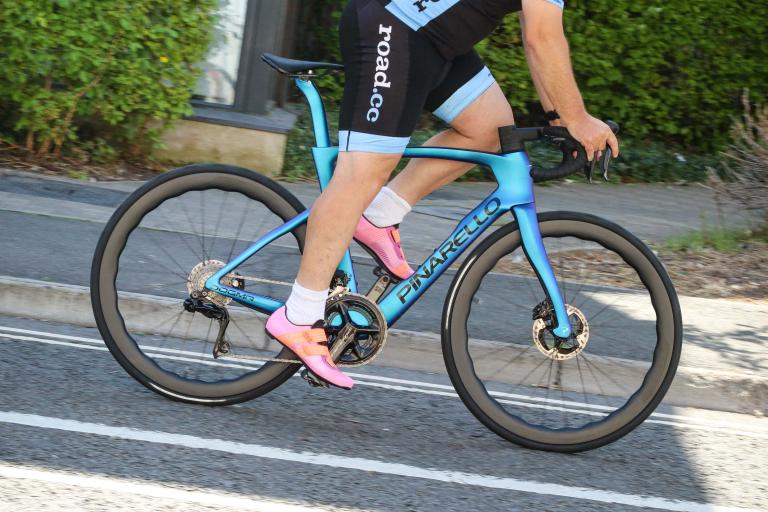
Add new comment
12 comments
Efficent and aesthetic rarely go hand in hand but thats the price of progress to go faster id give it a go.
Looks like a monster....white saddle doesn't help!
Goodness me, bikes are getting uglier this season
I think the frame is actually very nice, still not a fan of the aesthetics of disks but I like the colour way on the frameset
Almost seems the company's more interested in concept bikes - this definitely has a whiff of concept to it. I like the idea of exploring a bike without seatstays, but I'm guessing that's not UCI legal either?
Not a fan at all, and that's one expensive bike. £4600? Golly.
Yes, saying it 'inspired strong feelings in most who saw it' is certainly a diplomatic way of putting it.
I also wonder how aero it actually is as the headtube looks distinctly .. ahem .. 'sportive' bike to me.
Still, doubtless those kamm-tails will make it fly along. It'll probably almost pedal itself.
truly hideous. the disc brakes dont help the ungainly look.
*barfs*
FUGLY!
If you squeeze hard you can flex the top tube of a 531 Pro steel frame between finger and thumb also (not ever so much though!)
A decent review of a bike that would be easy to knock.
You have to give Culprit their dues, they've attempted to push a lot of boundaries here and it looks like they've largely succeeded. Is it a bit 'Jack of All Trades' though? I'm struggling to imagine who might buy one of these. Weight might be an issue for a lot of people, but I guess with both aero and discs a penalty there is inevitable.
Much as I love Marmite, I can't look at that paintscheme for too long without it offending me. Sounds like they have that covered in terms of other options, but if I were sending a new bike model out to get people's attention, I'd want it painted as gorgeously as possible.
Stevie Wonder has one on order already?